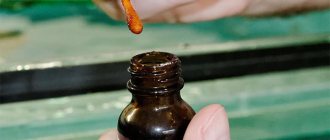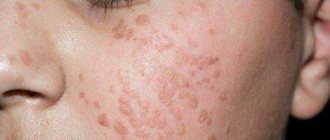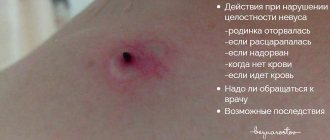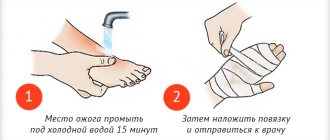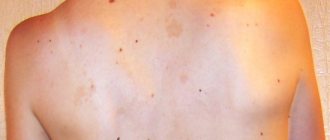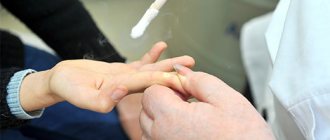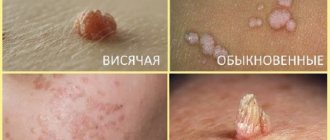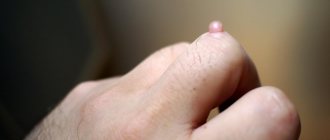Warts are by no means random formations, but a consequence of activation of the human papillomavirus (HPV). This virus affects most people on earth, and it rarely poses a serious danger. The virus manifests itself in the form of epidermal neoplasms of various shapes and sizes.
What happens if you tear off a wart, is it dangerous and what measures to take if the growth was torn off by accident - these are very important questions for people infected with HPV. Injuring a wart can lead to complications and secondary infections.
Causes and types of warts
In medical practice, there are several types of warts. It can be:
- Vulgar. This is the most famous type of growth. Appears in adults and children. They look like small cones with a loose surface. They may disappear without treatment.
- Plantar. Deep growths located on the feet or heels of the feet. They have a color from yellow to gray-blue.
- Flat. Small spots that protrude slightly above the surface of the skin. Flesh color. Often occur in patches.
- Genital warts. A cone-shaped growth that occurs mainly on the mucous membranes of the genital organs, as well as in the perineum and anus. The color is dark, the consistency is elastic to the touch.
- Thread-like. Small convex papillary growths. They appear on the neck, under the arm. The most susceptible are the injured.
The main reason why growths appear on the body is the human papillomavirus. Up to 70% of the entire population is infected with this virus, but most of them are not even aware of the disease.
HPV can manifest itself in the form of wart growth under the following factors:
- reduced immunity;
- poor nutrition;
- hormonal disbalance;
- excess weight;
- hypothermia;
- sudden weight loss;
- lack of personal hygiene.
These are the most common causes of warts appearing on the body.
Structure of a wart
The top of the growth is covered with a dense keratinized surface consisting of dead cells. These cells prevent infection from entering and infecting the wart.
Next comes the root. Blood vessels lead to it, supplying the growth with nutrients. You cannot pull out the root yourself.
Due to the proximity of the capillaries, if the growth is damaged, bleeding may begin. How abundant it will be depends on the size.
Causes
Warts are considered benign skin growths. The cause of their appearance is the human papillomavirus, which is transmitted through various types of contact between people. Today, more than 600 strains of HPV are known and more than 60% of people are carriers. The age at which these formations appear is not important, but it has been noted that in most cases, warts begin to grow in children and adolescents. Older people are least susceptible to this.
Reasons why warts occur:
- infection with a virus from a sick person;
- decreased immunity;
- hormonal changes that occur during adolescence;
- hormonal imbalance in adults;
- diabetes;
- excess weight;
- pregnancy;
- sexual activity at an early age;
- unprotected sexual intercourse;
- hypothermia;
- features of professional activity;
- neglect of personal hygiene rules.
Which warts are susceptible to injury?
Most of all, the injured are large growths that you want to pick out. It is easy to pick off such a wart by accident.
If the wart is located in a place where there is constant friction with clothing or shoes, then as it grows it can become injured and subsequently come off.
Small thread-like formations have a loose structure, so with the slightest friction they bleed and may fall off.
Condylomas and papillomas have a shape that stands out above the surface of the skin. If located in an area where there is friction with clothing or linen, it is necessary to get rid of such growths as soon as possible so that if damaged, the wound does not become infected.
How can you damage a wart?
Any owner of papillomas has at least once encountered their damage in everyday situations. It is very easy to accidentally injure the body of a wart. This may happen if:
- use the razor carelessly;
- scratch in places located in close proximity to the growth;
- accidentally touching items of clothing and accessories or tearing out a growth when changing them; Hanging warts on the body especially suffer because of their shape;
You can cut the growth while shaving
- hit or fall; this often happens with tumors on the elbows and knees;
- erase growths on the legs and feet when wearing hard shoes or damage them while walking barefoot;
- cut off a wart on a finger or other part of the hand with a knife when cooking.
Aside from accidental injuries, some people try to put an end to the troublesome condition on their own at home, resorting to extreme measures. By picking, cutting off the stem with tweezers or pulling out the body of the growth, it is impossible to completely get rid of the infected cells. But unpleasant consequences cannot be avoided.
What actions most often cause warts to come off?
The growths located in the area of friction with clothing are torn off and pulled out at the slightest contact. If they are located in a place where a person regularly shave, careless movement can easily damage the wart.
If a wart on your hand comes off, it is mainly a consequence of frequent contact with household chemicals. A torn wart brings great discomfort.
You need to carefully monitor if growths affect the skin of small children. Children can scratch them and accidentally tear them off.
What happens if you pick off a wart?
If a wart is peeled off, it often bleeds. An open wound also appears; if an infection occurs, infection and suppuration may begin. This will prolong the healing time of the affected area.
Also, after the wound heals, a scar or scar forms, which will have to be further removed. If you accidentally puncture or tear off a wart and it starts to bleed, you should consult a doctor immediately.
How to prevent accidental damage to warts?
You cannot remove warts on your own, but accidental damage to the warts can be prevented. To do this, you need to follow and follow some of the recommendations that will help reduce the risk. There are few of them and they do not require special conditions and funds. The general list of recommended activities is as follows:
Caution in daily life and hygiene will help to avoid accidental injury to warts.
- cut your nails short;
- If possible, wear loose, non-tight underwear;
- do not use rough washcloths;
- after a shower, use soft towels, pat the skin gently, do not rub harshly or roughly;
- Particularly disturbing formations should be removed in medical institutions.
By following these simple rules, you can make it easier to coexist with warts. Under no circumstances should you cut off a wart yourself or remove it using any other method. If it comes off accidentally and damages blood vessels, you should immediately take a series of measures to treat the affected area, then show it to a doctor. The best method to prevent damage is to remove it in a timely manner.
How to stop bleeding
If a wart is picked accidentally or intentionally, it will begin to bleed. Also, if you notice that blood is coming from a condyloma or papilloma, this is the first sign that the wart is damaged or will soon come off.
If the wart bleeds and the bleeding is light, it can be stopped with a simple cotton pad or swab.
If there is excessive bleeding, apply a tight bandage or tourniquet. Even if the bleeding is successfully stopped, a consultation with a dermatologist is necessary. It may be necessary to remove any remaining loose debris from the wound.
If the bleeding is severe and cannot be stopped, you should consult a doctor immediately!
What steps to take next
What to do if you rip off a wart? This is a common question during consultations with a dermatologist. If you see that the wart is coming off or has already come off, you need to take action.
You need to make sure that the wound does not get infected. To do this, it should be sealed with adhesive tape. If the affected area is large, then bandage it with a bandage.
If necessary, the doctor will prescribe ointments or other medications to help promote rapid healing.
Is it possible to tear off papillomas yourself?
If a person ruptures a human papillomavirus neoplasm, he may face serious problems.
Firstly, pathogenic bacteria can get into the resulting wound, which will cause inflammatory processes.
Secondly, there will be a violation of the skin, which can lead to bleeding.
Thirdly, infection of surrounding tissues with the HPV virus may occur, since it is contained in large quantities in papillomas cells.
It is worth noting that any mechanical impact on a papillomavirus neoplasm can lead to its degeneration. If a person involuntarily or intentionally had to rip off a papilloma, then he needs to contact an oncologist or dermatologist for consultation.
Is it possible to get infected from a person if you touch a wound?
There are quite a lot of cases of infection of a healthy person through contact with a wound of a patient. This should not be done under any circumstances, because there is a possibility of becoming infected with the human papillomavirus. Warts appear more quickly in those who have touched the wounds with unprotected hands. This is due to the fact that the blood contains a significantly higher concentration of the virus, and the skin of any person always has microcracks that become entry points for infection.
Gloves should absolutely always be worn when treating the wounds of other people to avoid contact with the skin in large concentrations of not only HPV, but also other infections - HIV, viral hepatitis, etc.
If the bleeding does not stop and the wound needs to be treated, gloves should be worn to prevent infection.
Is it possible to cut off warts?
Many people, noticing that they have a growth, do not rush to see a doctor. Especially if the wart is in an intimate place. Many people are engaged in removing growths on their own.
As medical practice shows, those patients who independently cut off warts with scissors then underwent an additional course of treatment.
If you cut off warts at home, you will never be able to get rid of them. The root, which is the basis, will continue to be in the body, thereby giving life to new formations. It must be cut out or removed additionally.
What to do when you rip it off?
Sometimes the integrity of a growth on the body is broken completely by accident. If a wart comes off or tears, you need to take a number of preventive measures that will reduce the risk of infection and spread of the virus to healthy areas of the skin. For this purpose it is necessary:
- Treat the skin with a disinfectant. It is quite possible to use any disinfectant that is at hand, for example, hydrogen peroxide, Chlorhexidine, Miramistin, etc.
- Cover the wound with a bandage to prevent infection. It is best to use a special sterile patch, the central part of which is not adhesive.
- Seek medical help.
If suddenly the wart was injured, but remained on the skin, you should not try to pick it out or cut it off. Such a neoplasm should be shown to a doctor as soon as possible.
How to stop bleeding?
Warts are insidious in that even after minor damage they can bleed for a long time, and stopping the bleeding can be very difficult. If there is blood coming from the growth, it is worth folding a small piece of sterile bandage in several layers and pressing it more tightly to the problem area. Keep the bandage on for about 10 minutes, and during this time the bleeding should stop. Next, you can treat another piece of bandage with an antiseptic and press it again to the wound. For processing you can use:
- Hydrogen peroxide.
- Potassium permanganate solution.
- Fukortsin.
- Medical alcohol.
- Propolis tincture.
Keep the antiseptic compress on for about five minutes or more. This will help stop the bleeding.
If suddenly a wart bleeds on its own without injury, and bleeds quite regularly, you must definitely show it to a doctor, and the specialist will decide what to do next with the growth. Such a symptom may indicate the development of cancer.
Further treatment
If the wart has been injured, it cannot be treated at home. Such a growth should definitely be shown to a doctor. The specialist can:
- Carry out an inspection.
- Order a number of additional studies, including skin scraping and biopsy.
- Remove any remnants of the wart directly at the appointment, including using a regular scalpel. The doctor can send such material for histological examination to detect cancer cells.
- It is recommended to remove the remaining growth using cryotherapy, laser or radio wave treatment.
- Prescribe medication, for example, taking antiviral or antiseptic drugs.
Any treatment of warts on the body must be performed under the supervision of a doctor.
First aid
If a wart is cut or torn off, it begins to bleed. You should immediately consult a doctor, but before that you should provide first aid. It is as follows;
- The damaged area is treated with antiseptic agents: hydrogen peroxide, chlorhexidine.
- Then, when the wound dries, it is covered with a plaster.
- If there is a lot of bleeding from the wart, a tourniquet or bandage is applied.
- Under no circumstances should you throw away a wart. It is necessary to give it to a doctor, who should be contacted in any case, for further examination. This is necessary to exclude malignant degeneration.
Treatment options at home
It’s worth noting right away that this is the most risky and unwise decision you can make. If you pull out the remnants of a wart or start treating its remaining fragment, you can use some drugs from the pharmacy for such purposes.
Must read: Homeopathy for warts
The same “Kolomak” or “Ferezol” will make it possible to remove a damaged wart, but you should be aware that they all practically burn out the cells of the neoplasm, and with the slightest damage to the growth, this can lead to severe burns, the formation of wounds, infection and much more.
Some advise treating areas with warts with celandine, even if it is a torn wart, or using various recipes from traditional medicine. Be that as it may, there is no point in talking much about this, since we are talking about the potential development of cancer, and there is no point in thinking about any self-medication here.
Neither pharmaceutical products, nor folk recipes, nor, especially, self-removal of warts, will do anything good unless you first consult a doctor.
Risks arising from injury to the growth
What to do if a wart bleeds? What to do if a wart comes off? Why can’t you pick them and remove them yourself? Why did new formations appear again? All these questions arise after the job is done and the blood has flowed.
If the growth is damaged, the body risks getting an infection, which can lead to inflammation of the growth on the skin and even death due to blood poisoning.
Body temperature may also increase and the damaged area will be very painful. The formation of a bleeding wound will increase the pain effect.
When bleeding occurs, infected blood can get onto healthy skin, thereby creating an environment for the appearance of neoplasms. The wound will heal over time, but the scars and scars will remind you of themselves all your life.
What happens if you tear off a wart?
If its leg comes off, inflammation of the epidermis begins. An open wound is a gateway for infection to enter the body. Inflamed skin changes color and swells. These phenomena are accompanied by itching, burning and an increase in local body temperature.
On this topic
- Warts
All about removing warts with nitrogen
- Inna Viktorovna Zhikhoreva
- September 27, 2021
Cutting off warts on your own can cause the following adverse effects:
- Excessive bleeding as a reaction to mechanical trauma to the skin. The appearance of hemorrhage is caused by the intensive proliferation of blood vessels at the site of wart formation.
- The spread of virus to healthy areas of the skin, which contributes to the formation of new growths.
- The appearance of scars and cicatrices on the skin. They are difficult to remove, and they can be noticeable on the face, which spoils a person’s appearance.
- Infection of the wound surface. An open wound in a person infected with the papilloma virus is prone to infection due to decreased immune defense. Infection of the wound is manifested by swelling, hyperemia, and suppuration. Often, wound infection can cause general sepsis.
If after cutting off the wart there is no suppuration, redness of the skin, or pain, then this may indicate that there is no papillomavirus in the body. But even in this case, there is no absolute guarantee that a malignant process will not develop on the affected area of the skin.
Sometimes a wart can masquerade as a malignant tumor, such as melanoma or basal cell carcinoma. If you tear it off, it will be an impetus for the intensive growth of a cancerous tumor.
Treating it with home remedies can only increase the progression of cancer. In advanced cases, the tumor spreads metastases to nearby lymph nodes or to distant organs of the body.
Possible consequences
If a wart comes off and a person does not pay special attention to it, this can lead to unpleasant consequences. First, an infection may get there. Then the affected area will begin to rot and tear.
After the pus comes out, an open wound forms. When it heals, it will leave a scar.
What happens if you cut off a wart at home? The consequences of self-removal will not take long to come:
- bleeding wound;
- increased body temperature;
- painful sensations.
Laser wart removal
The procedure is performed under local anesthesia after the doctor has administered painkillers. Depending on the size of the derivative, laser removal of warts takes up to 15 minutes. After the procedure, a bandage is applied and medications are prescribed to lubricate the wound as it heals.
Laser wart removal
The main advantage of laser wart removal is that just one procedure is enough to make the wart that bothers you disappear forever. In addition, this treatment method is the most common among patients and has the best reviews, since laser warts are removed from:
- faces;
- palms and feet;
- genitals.
Precautionary measures
If it happens that a wart breaks off on any part of the body, you must adhere to the following rules:
- Never touch the torn area with dirty hands.
- If there is contact with a sore spot, you need to treat your hands with an antiseptic or wash them thoroughly with soap.
- Wound treatment procedures must be carried out with gloves.
- Do not touch the wound with your hands and do not let other people touch it except the doctor.
- Seek help from a specialist.
A growth that protrudes strongly above the surface of the skin should be under special supervision, especially for children. It is necessary to ensure that the child does not scratch or injure the infected area.
If the wart comes off and there is no way to see a doctor, the sore spot must be carefully treated with wound-healing medications. When applying the ointment, you should avoid getting it on healthy skin of the body.
In order to completely remove growths and get rid of relapse, it is necessary to strengthen the immune system, because it is precisely its decrease that provokes more and more new formations. You also need to pay attention to the appearance of redness and growths.
How does papilloma work?
Papillomas are benign neoplasms that, in the presence of accompanying factors, can become malignant. Such neoplasms are similar to warts, but have a different shape and structure. Most often, in patients with HPV, there is localization of hanging processes on various parts of the skin, the size of which can reach 2-3 cm:
- flat warts, have a round or oval shape, reach 1-2 mm;
- vulgar warts, have a rough surface, rise above the skin by 2-3 mm;
- genital warts, in appearance resembling the comb of a rooster or a head of cauliflower, are localized in skin folds, on the organs of the genitourinary system, in the oral cavity;
- filamentous papillomas (pedunculated), have a round or thread-like shape, their size does not exceed 5 mm, most often appear in people of the older age group, etc.
